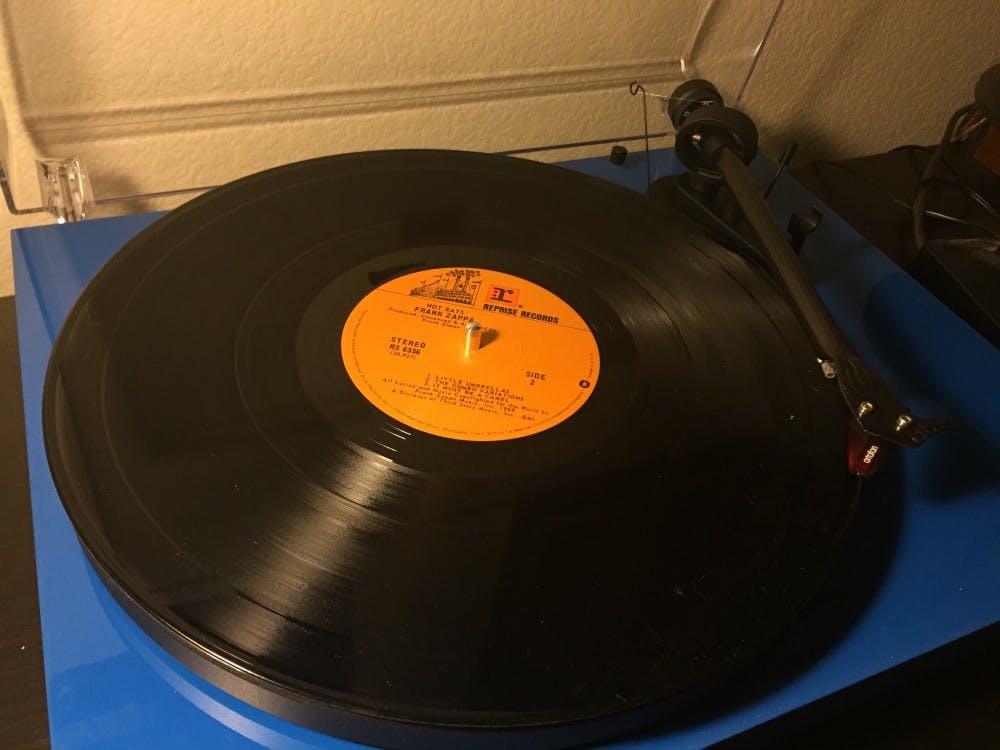
Welcome to The Vinyl Voyager. My weekly diary of what music on vinyl, in its purest form, means to me. Track-by-track, note-by-note: Here’s what influences me and keeps me moving forward in a world that won’t stop pushing back.
When you’ve been described by the best in the business as a rock icon, an innovator and a true musical genius, your career is probably headed in the right direction. Frank Zappa, a politically-charged maverick who always sought to push his art to the limit, is a difficult egg to crack. His often comedic albums never shied away from incorporating low-brow satire with complex compositions.
Zappa’s band, the Mothers of Invention, released what many now consider to be one of the first rock concept albums — 1966’s “Freak Out!" For the next 30 years, Zappa would continue to inseminate listeners around the world with his eclectic musical prowess and empower generations of musicians through his constant combating of groups who would seek to censor the art form for the masses.
Despite all his accomplishments though, nothing in his discography sticks out more to me than 1969’s jazz fusion and nearly instrumental “Hot Rats.” Alongside contemporaries like Miles Davis with his album “Bitches’ Brew” and Santana’s “Caravanserai,” Zappa made jazz fusion accessible with brighter sounds and hooks.
So, let’s try to ignore the utterly terrifying album cover and dive into “Hot Rats” head first — on freshly cleaned, virgin black vinyl of course.
1. “Peaches en Regalia”
Zappa helped pioneer the manipulation of recording tape speed to achieve interesting tones and colors in his music. The opening of “Peaches,” now a jazz fusion standard, boasts with what sounds like speedily picked guitar altered by Zappa’s signature tape altering and is supported by a whirlwind of piano chords and woodwinds. I always found this track to be the most difficult to appreciate on the album, granted jazz fusion isn’t the most instantly likable genre of music. Regardless, the dozen or so color changes will dazzle anyone willing to give a second listen and appreciate what Zappa managed to record in 1969.
2. “Willie the Pimp”
Featuring the gravel and grit of Captain Beefheart’s vocals, “Willie the Pimp” is the only non-instrumental song on “Hot Rats”; it’s also arguably the best. Pairing the Beefheart growl with a riffing combination of electric violin and guitar culminates into a core melody heavy enough to match the “little pimp with (his) hair gassed back” walking the streets. Zappa puts his guitar virtuosity on display here, unleashing a relentless solo I’ve always considered a favorite.
3. “Son of Mr. Green Genes”
Playing like the cousin of “Peaches en Regalia,” Zappa arranges his band back into jazz-fusion territory, reintroducing a composed sound and instrumentation. Ian Underwood’s piano takes charge for much of the track, implementing his mastery to its fullest extent. At around three minutes in, a deep saxophone line bounces “Green Genes” into more furious soloing from Zappa and company. Drummers can get an education here too as Paul Humphrey teaches how to get in line behind the lead melodies while still exacting a force of rhythm tight enough to wall-off a tsunami.
4. “Little Umbrella”
Zappa reigns in the chaos here, settling into a more straightforward jazz sound. The lack of immense soloing makes “Little Umbrella” the shortest track on the album, and the weakest. I’ve never enjoyed this song unfortunately, and it’s only annoyance with “Hot Rats” on vinyl is that you can’t really skip it.
5. “The Gumbo Variations”
Zappa surrounds himself with the best musicians around and “The Gumbo Variations” is his proof of concept. This track practically beheads its slouchy predecessor right from the start. Underwood cranks out a phenomenal sax solo backed by a downright funky groove that’ll get the stiffest person jiving. Back again is Don “Sugarcane” Harris with an electric violin solo to rival any guitar lord’s best work. I can’t even begin to put the genius drum work into words. The sheer energy driving “The Gumbo Variations” is palpable and will leave you in awe at the stamina behind its performers. Just listening to it will work up a sweat. Thank god for gumbo.
6. “It Must Be a Camel”
The beginning sort of meanders around with a somber piano, bass and drum trio that is oddly beautiful. “It Must Be a Camel” doesn’t become an album highlight, though, until the back half of the track where Zappa and Underwood join to interplay wonderfully between their drastically different instruments. Drummer John Guerin cascades up and down his toms giving the song an iron backbone. “Camel” closes a near perfect album of jazz freak outs with neatly drawn compositions and a lush sound.
Tell the reporter about your vinyl collection at nlatona@asu.edu or follow @Bigtonemeaty on Twitter.
Like The State Press on Facebook and follow @statepress on Twitter.






